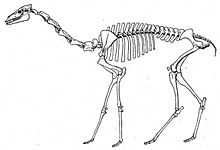Oxydactylus
| Oxydactylus Temporal range: late Oligocene to ?middle Miocene | |
|---|---|
 | |
| Skeleton of Oxydactylus longipes in the Field Museum of Natural History, Chicago | |
| Scientific classification | |
| Kingdom: | Animalia |
| Phylum: | Chordata |
| Class: | Mammalia |
| Order: | Artiodactyla |
| Family: | Camelidae |
| Tribe: | Camelini |
| Genus: | †Oxydactylus |
| Species | |
|
O. lacota | |
Oxydactylus is an extinct terrestrial herbivorous genus of the tribe Camelini, family Camelidae, endemic to North America Oligocene through the Middle Miocene (30.8–13.6 mya) and in existence for approximately 17.2 million years.[1]
Oxydactylus is from the Ancient Greek οξύς (oxys, "sharp")and δάκτυλος (daktylos, "finger")
Taxonomy
Oxydactylus was named by Peterson in 1904. Its type is Oxydactylus longipes. It was assigned to Camelidae by Peterson (1904) and Carroll (1988).[2]
Morphology

They had very long legs and necks, and were probably adapted to eating high vegetation, much like modern giraffes. Unlike modern camelids, they had hooves, rather than tough sole-pads and splayed toes.[3]
Four specimens were examined by M. Mendoza, C. M. Janis, and P. Palmqvist for estimated body mass.[4]
- Specimen 1: 183.3 kg (404.1 lb)
- Specimen 2: 115.9 kg (255.5 lb)
- Specimen 3: 116.5 kg (256.8 lb)
- Specimen 4: 126.3 kg (278.4 lb)
Species

O. benedentatus (syn. Procamelus concerptus), O. cameloides, O. campestris, O. lacota, O. longipes (type species), O. longirostris, O. lulli, O. wyomingensis
References
- ↑ Paleobiology Database: Oxydactylus basic info.
- ↑ R. L. Carroll. 1988. Vertebrate Paleontology and Evolution. W. H. Freeman and Company, New York 1-698
- ↑ Palmer, D., ed. (1999). The Marshall Illustrated Encyclopedia of Dinosaurs and Prehistoric Animals. London: Marshall Editions. p. 277. ISBN 1-84028-152-9.
- ↑ M. Mendoza, C. M. Janis, and P. Palmqvist. 2006. Estimating the body mass of extinct ungulates: a study on the use of multiple regression. Journal of Zoology